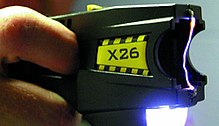
Back مسدس صاعق Arabic Taser BCL Тейзър Bulgarian Taser Czech Taser Danish Elektroschockpistole German Taser Estonian تپانچه برقی Persian Taser X-26 French טייזר HE
This article has multiple issues. Please help improve it or discuss these issues on the talk page. (Learn how and when to remove these messages)
|



A TASER (also variously "Taser" or "taser") is a conducted energy device (CED) primarily used to incapacitate people by delivering an intense electric shock that briefly disrupts voluntary control of the muscles, allowing the person to be approached and handled without resistance. The brand-name product, sold by Axon (formerly TASER International),[1] is a handheld device which fires two small barbed darts intended to puncture the skin and remain attached to the target until removed by the user of the device. The darts are connected to the main unit by thin wires that achieve a high dielectric strength and durability given the extremely high-voltage electric current they conduct (typically 50,000 volts, or 2,000 volts under load), which can be delivered in short-duration pulses from a core of copper wire in the main unit. This enormous rush of current into the body produces effects ranging from localized pain to strong involuntary long muscle contractions, causing "neuromuscular incapacitation" (NMI), based on the mode of use (tasing frequency and environmental factors) and connectivity of the darts.[2] When successfully used, the target is said to have been "tased".
The first TASER conducted energy weapon was introduced in 1993 as a less-lethal option for police to use to subdue belligerent or fleeing suspects, who might otherwise need to be subdued with more lethal means such as firearms. As of 2010[update], according to one study, over 15,000 law enforcement and military agencies around the world used TASERs as part of their use of force continuum.[3] In the United States, TASERs are marketed as less-lethal (as opposed to non-lethal), since the possibility of serious injury or death still exists whenever the weapon is deployed. At least 49 people died in 2018 after being shocked by police with a TASER.[4] Personal-use TASERs are marketed in the US but prohibited in Canada, where there is a categorical ban on all conducted energy weapons such as stun guns and TASERs, except for use by law enforcement.
A 2009 report by the Police Executive Research Forum in the United States found that police officer injuries dropped by 76% in large law enforcement agencies that deployed TASER devices in the first decade of the 21st century compared with those that did not use them at all.[5] Axon and its CEO Rick Smith have claimed that unspecified "police surveys" show that the device has "saved 75,000 lives through 2011".[6][7] A more recent academic study suggested police use of conducted energy weapons in the United States was less risky to police officers than hands-on tactics, and showed officer injury rates equal to those experienced by officers using alternative incapacitation methods such as pepper spray.
- ^ "TASER X26". Archived from the original on September 27, 2014.
- ^ "Neuromuscular Incapacitation (NMI)", TASER International, published March 12, 2007. Retrieved May 19, 2007 Archived April 13, 2008, at the Wayback Machine
- ^ Cite error: The named reference
policeusewas invoked but never defined (see the help page). - ^ Cite error: The named reference
:0was invoked but never defined (see the help page). - ^ Taylor B (September 2009). "Comparing safety outcomes in police use-of-force cases for law enforcement agencies that have deployed Conducted Energy Devices and a matched comparison group that have not: A quasi-experimental evaluation" (PDF). National Institute of Justice.
- ^ Roberts D. "A new life for Taser, this time with less controversy". Fortune. Retrieved September 14, 2011.
- ^ "Taser.org".